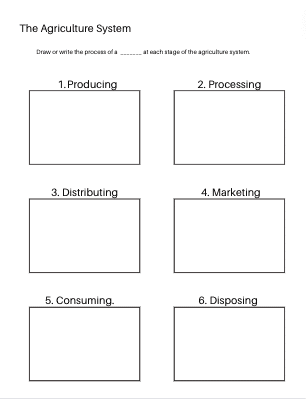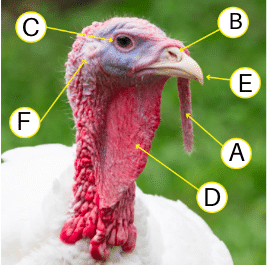The Minnesota Agriculture in the Classroom program (MAITC), is a unique public/private partnership between the Minnesota Department of Agriculture and the MAITC Foundation. The program goal is to advance agricultural literacy to all learners, especially K-12 students, and educators.
MAITC’s mission is “to promote understanding and awareness of the importance of agriculture.”
We are pleased to offer the free AgMag series for kindergarten through 6th grade. Each issue is written and targeted to each specific grade level. The magazine is sent early in the school year for beginning readers. Teachers can use it when the reading level of their students matches the reading level of the magazine. We publish two issues each school year, in October and March. Enjoy!
Why Ag in the Classroom?
Previously, people were very aware of the role agriculture played in their lives—it meant survival. Nearly everyone—men, women, and children—worked the land.
Agriculture still means survival. That will never change. But as time goes on, fewer people have close contact with farming. They’re not aware of their own—and the nation’s—total dependence on agriculture. Think about it:
- Fewer than 2 out of 100 Americans work directly in production agriculture (farming). This small group meets the food and fiber needs of the nation as well as many people abroad.
- Agriculture, along with its related occupations, is one of the nation’s largest industries, generating billions of dollars each year; one out of every five jobs depends on it in some way.
Agriculture is constantly changing. But one thing remains the same: Agriculture is a vital part of your day! It’s important for students to gain an understanding and appreciation for the ways agriculture touches their lives, each and every day. Food doesn’t magically appear in the grocery store or on the kitchen table. It all starts with agriculture.
About Your AgMag
The AgMag is a great supplement to your social studies, science, or language arts curriculum. You’ll get two issues per school year: October and March.
AgMag Theme: Agriculture, the Land, and You!
- Overview of Producers and Consumer roles in agriculture
- Explanation of the Agriculture System
- The farmer’s role in the Agriculture System
- A turkey’s life in the Agriculture System
- Minnesota’s Turkeys and Sugarbeets
- Egg Activity: What Do Animals Need to Survive?
- Agriculture Inventions
Integration Ideas
Social Studies
- Diagram the path of production for a processed product, from farm to table
English Language Arts
- Ask students to identify key ideas and details and build their vocabulary through the AgMag’s informational text.
- Use agriculture as an inspiration for creative writing activities and group discussions. Ideas: Stories from the points of view of plants or animals that depend on humans; predictions for agriculture in 2050 (or future years); letters to children in other countries with descriptions about agriculture here and questions about agriculture there.
Science and Math
- Have the students create diagrams of an animal/plant of their choosing following the examples on page 6 to help them identify similarities and differences between different organisms.
Minnesota Academic Standards Connection
| Subject | Standard Code | Benchmark |
| Social Studies | 3.2.10.1 | Explain that consumers have two roles – as sellers of resources and buyers of goods and services. Explain that producers have two roles – as sellers of goods and services and buyers of resources. |
| Social Studies | 3.4.21.1 | Explain how an invention of the past changed life at that time, as well as positive, negative and unintended outcomes of the invention. |
| Science | 3L.3.1.1.2 | Develop multiple models to describe how organisms have unique and diverse life cycles but all have birth, growth, reproduction, and death in common. (P: 2, CC: 4, CI: LS1) Emphasis is on the pattern of changes organisms go through during their life. Examples of models may include diagrams, drawings, physical models, or computer programs. |
| Science | 3L.4.2.1.1 | Obtain information from various types of media to support an argument that plants and animals have internal and external structures that function to support survival, growth, behavior, and reproduction.** (P: 8, CC: 4, CI: LS1) Examples of structures may include thorns, stems, roots, colored petals, heart, stomach, lungs, brain, and skin. Examples of media may include electronic sources. |
| English Language Arts | 3.1.5.2 | Use informational text features (e.g., captions, subheadings, glossaries, indexes, and interactive images) to understand information relevant to a given topic. |
Glossary
Some words in your AgMag may be unfamiliar to your students. Many are defined in the articles. There is also a glossary on the AgMag website: https://mnagmag.org/glossary/ Words you might wish to pre-teach are:
AGRICULTURE: Growing plants and raising animals that people use for food, clothing and many other things every day. It’s also harvesting those farm products and getting them to us so we can use them. Agriculture is the industry that grows, harvests, processes, and brings us food, fiber, fish, forests, sod, landscaping materials, and more. It uses soil, water, sun, and air to produce its products. The process starts on farms, orchards, gardens, and ranches with the growing and the harvesting of crops and livestock, then moves to processing plants before finally traveling as finished products to stores, farm markets, lumberyards, greenhouses, and more where consumers buy the products. Agriculture is connected in some way with almost everything we eat, wear, and use.
Quote from an Unknown Source: “Agriculture is not simply farming. It’s the supermarket, the equipment factory, the trucking system, the overseas shipping industry, the scientist’s laboratory, the houses we live in, and much more. It has an effect on the air we breathe, the ground we walk on, the water we drink, and the food we eat.”
PRODUCER: a person, company, or country that makes, grows, or supplies goods or commodities for sale. Farmers are producers.
CONSUMER: a person who purchases goods and services for personal use.
HUMAN RESOURCES: the workers and employees who help process the product.
NATURAL RESOURCES: materials or substances such as minerals, forests, water, and
fertile land that occurs in nature and can be used for economic gain.
CAPITAL RESOURCES: man-made tools and equipment used to produce a product. Examples of capital resources are factories, equipment, and tools such as hammers, saws, and computers.
AgMag Cover: Agriculture, the Land, and You!
Discussion Prompts
- Where do you get food, clothing, or supplies to build houses? Where do you think those items come from? Who grows or makes them?
- What would we do if there were no farmers?
Engagement Activity: Where does this come from? Tracing Origins – the origins of everyday items
- The point of this short activity is to help students recognize that everything they use/consume comes from somewhere. Someone had to make, assemble, process, transport, grow, create that item from the earth’s resources.
- Show your class a standard piece of paper (You could use almost any object, but we’ll use paper as an example). Ask the class to help you track the process it took to get this piece of paper into their classroom. Ask the question “How did it get there? Or who made it that way?”” at each step to find the next step until you get down to the raw material. Consider writing or displaying the steps in front of the class as you discuss the process so students can visually understand all the resources required.
- Example: Paper in school → someone bought the paper at the store and brought it to the school→ someone stocked the paper on the shelves → someone shipped the paper to the store → someone made the paper at a warehouse → someone had to gather the materials to make the paper → someone had to grow the raw materials to make the paper.
- Feel free to try this example with other items the students suggest. Students can work in pairs for 5 minutes tracing the origins of an item of their choosing.
- Note: this activity can be as simple or complex as you want it to be. As an engagement activity, this can be done in 5 minutes or less, but could be developed further into a research or informational writing project.
Page 2 Steps Along The Way
Discussion Prompts
- Where do the materials come from that make up what we eat, wear, and use every day?
- Which takes more time to produce: Grain becoming a loaf of bread, or a carrot that goes into your salad?
- Answer: A grain becoming a loaf of bread takes more time because there are more steps to process grain into bread.
- Consider making a T-chart on the board with “Grain to Bread” in one column, and “Carrot into a Salad” in the other. Brainstorm with your class the different steps that need to happen and write the steps for each. This is a great visual exercise for students to see the steps laid out.
- Answer: A grain becoming a loaf of bread takes more time because there are more steps to process grain into bread.
Agriculture System
Consider taking a product (a food item would be most intuitive) and discussing each step of the agriculture system for that specific product. Ideas: Milk, cereal, granola bars, rice, etc.
Consider using this practice worksheet for kids to work solo or in pairs to draw in and fill out a different agriculture product at each stage of the agriculture system.

Page 3: Naming & Matching and Meet The Farmer
Naming & Matching
Answers:
Top row, left to right: Distributing, Marketing, Consuming
Bottom row, left to right: Producing, Disposing, Processing
Meet The Farmer
For more information on raising sugarbeets, check out this video!
Discussion Questions
What role does the farmer (producer) play in the agriculture system? Farmers plant, grow, care for, and harvest crops.
Why are sun, air, water, and soil part of the agriculture system? Sun, air, water, and soil are all things that plants and animals need in order to grow.
Page 4-5: Tracking A Turkey
Minnesota has 600 turkey farms! Minnesota has more independent turkey farmers than any other state in the U.S. These farmers raise between 40-42 million turkeys every year!
Discussion Questions
- Can you identify the six steps of the agriculture system in the Tracking a Turkey pages?
- What surprised you after you tracked the turkey?
For more information on turkeys, visit: https://www.eatturkey.org/ For a history tie in, read this article explaining the history of the turkey and the tradition in which the President of the United States pardons the Thanksgiving Turkey each year: https://www.eatturkey.org/history/
Page 6: The Trophy Goes To…
Discussion Questions
- What do you think Minnesota is really good at growing? What plants and animals do you see often? Minnesota is a top producer of sweet corn, soybeans, sugarbeets, grains like wheat, turkeys, pigs.
- What allows these plants and animals to grow in Minnesota? Natural resources like soil, water and sunlight, along with a climate that provides temperatures and environmental conditions for plants to grow. Some of these plants (soybeans, corn, grains) are food that allow animals like chickens, turkey, pigs and cattle to grow in Minnesota.
Match It Up: Turkey

Page 7: Egg-cellent
This is a great hands-on activity for students to diagram the different parts of an egg, as well as learn about the universal needs of living things. This activity has the potential to be messy (and fun!). Organize students into groups of 2-4 and let them work together to identify the different parts of an egg. Have them fill out the “Parts of An Egg Worksheet’ (linked). There is also a powerpoint linked with more in-depth information on the anatomy of an egg if you’d like to go over the content as a class.
Materials needed:
Eggs
Containers
Toothpicks
For the “Parts of An Egg” Worksheet, and the Facts about Chickens powerpoint, click the link below: https://minnesota.agclassroom.org/matrix/lesson/138/
Discussion Questions
What do animals need to survive? Water, food, shelter, air
Does a poult or chick need the same things to survive inside an egg as it does after hatching? Yes it does. A chick before it has hatched and after it has hatched needs air, and food/water
Materials needed:
Eggs
Containers
Toothpicks
Page 8: Agricultural Inventions
To help students with this activity, brainstorm ways in which an Egg-catcher could be created.
Some students may need a place to start so suggest they begin by thinking of materials they could use.
For a detailed historical timeline of Egg Farming, visit this link: https://unitedegg.com/about/evolution-of-u-s-egg-farming/
If you’d like to incorporate more standards in this activity, check out our “Engineering an Egg-Catcher” Lesson Plan for some additional ideas: https://4-h.org/wp-content/uploads/2016/02/Agriculture-in-Engineeri

